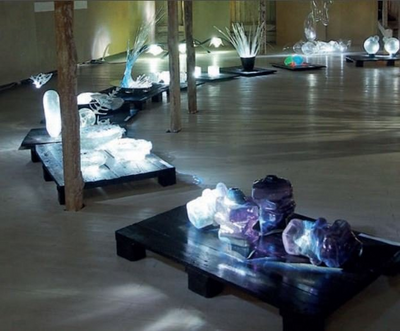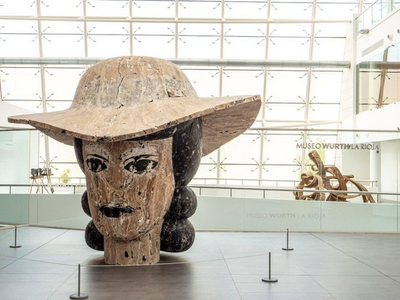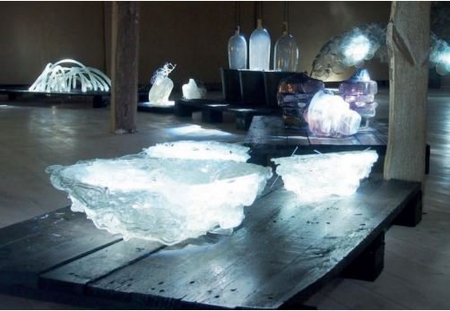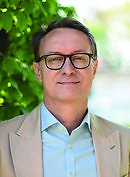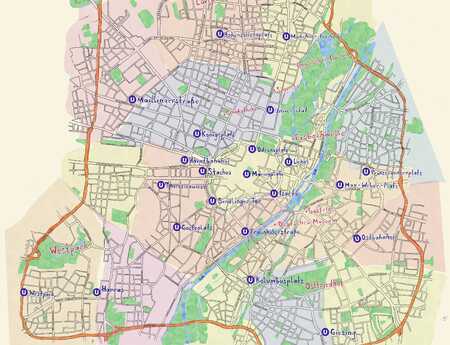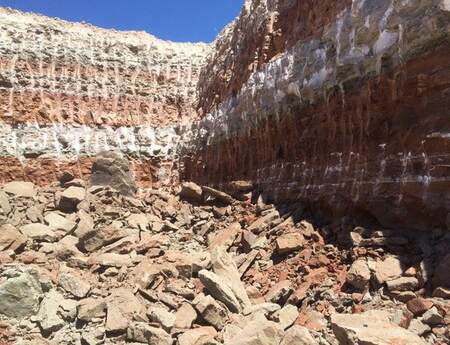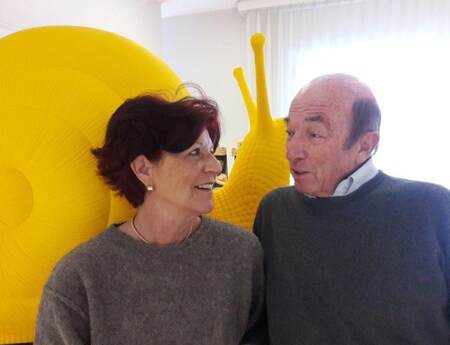In Search of a Miracle
sculpture network Experience Basque Country and Cantabria
It has been twenty-one years since a branch of the New York Guggenheim Museum opened in the industrial Basque city of Bilbao. It was the first museum in the world that succeeded in giving a city an entirely new appearance and opening up new economic opportunities. The metropolis in the Basque country had done well with its ship building and steel processing industries. But the global surplus production of steel plummetted Bilbao into a crisis in the 70’s and 80’s. Factories were forced to close and unemployment rose to almost thirty percent. The banks of the Nervión river were lined with empty factories. The government of the Basque country understood that Bilbao needed a new plan for the future. Just at that time the New York Guggenheim Foundation announced that they were expanding abroad. „The timing was perfect,“ said Guggenheim’s curator Petra Joos during sculpture network’s visit to Bilbao. At the beginning of the 90’s the Basque region offered Thomas Krens, then the Director of the Guggenheim, to take over all the costs for a new museum in their city. That included construction costs of US $100 million and expenses of $12 million annually. The American architect Frank O. Gehry was awarded the contract. He successfully designed a spectacular construction of gleaming titanium on the banks of the Nerviòn which abruptly put Bilbao on the map of global cultural centers. Bilbao’s glittering landmark attracted tourists, companies and creative minds and since then the economy has been on the rise. Even the global financial crisis in 2008 had less effect on the city than it did on the rest of Spain. The Bilbao effect and the miracle of Bilbao became notorious and have since seen many imitators: from the Spanish Santander all the way to Abu Dhabi, where an entire museum island is supposed to help prepare the city for a future without oil reserves. The extent of the fascination with the Guggenheim in Bilbao is also demonstrated in the newest thriller written by Dan Brown (The DaVinci Code, Inferno). In Origin (2017) the description of the museum and its artworks extends over dozens of pages.

During their trip to Bilbao, Rioja and Santander, the thirty member sculpture network group – consisting of artists and friends of the arts – experienced in detail how the Bilbao effect has stimulated Northern Spain. In the last few years avant-garde architecture has been created everywhere in the north. What’s more, it seems as if the region has a special affinity for sculpture. Some of the best known representatives of contemporary art have excellent pieces of work located in Bilbao and its surroundings.
When looking at the architecture of Northern Spain it is particularly notable how often Frank O. Gehry and Santiago Calavatra have realized several buildings. Both are known for their very artistic designs which are easily recognizable. When you land at the Bilbao airport it is like landing in the stomach of a sculpture. The Sondica airport terminal designed by the Spanish-Swiss architect Santiago Calatrava looks like a white bird. On the trip into the city, at the very latest on the La Salve bridge, you don’t know where to look first. On the bridge Daniel Buren’s bright red arches reach toward the sky (Arcos Rojos, 2007), on the right the Guggenheim with its shimmering titanium tiles looks like a scaled and winged prehistoric creature. A tower protrudes on the left side of the bridge which, since it is open on one side, allows for a view into the structure of the Guggenheim Museum. Located within walking distance of the museum is Santiago Calatrava’s white sail-like Zubizuri Bridge spanning the Nerviòn river. Behind it the twin towers of the Izozaki Towers rise - they are the work of the Japanese architect Arata Izozaki. The most recent example of the architectural boom in Bilbao is the new San Mames Stadium home of Atletico Bilbao, the local football team. The design, with its rippeling outer skin, is by the local architect César Azkarate.
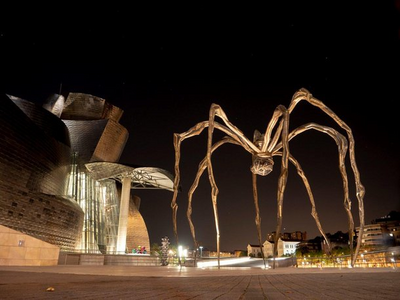
The sculptures that surround the Guggenheim include the aforementioned Arcos Rojos by Buhren, which were erected on the tenth anniversary of the museum in 2007. Located directly in front of the museum is Louise Bourgeois‘ giant bronze spider sculpture Maman (1999) – a homage to her mother. Created by the Japanese artist Fujiko Nakaya in 1998 the Fog Sculpture #08025 (F.O.G.) sprays water vapor several times a day and envelopes the esplanade and the man-made moat in front of the museum in mysterious shrouds of fog. After dark Yves Klein’s Fire Fountain starts up. The French artist dreamt of the project in 1959 in a presentation at the Sorbonne, but never realized it. He spoke of a public space, a pool of water and a fountain that shoots fire instead of water. He was inspired by the fountains in the gardens of the royal palace at La Granja de San Ildefonso near Madrid. Klein imagined „replacing the elegant water fountains with fire ... why not?“ His project was first made reality at the Bilbao Guggenheim. Next on the way to the museum comes Anish Kappor’s installation Tall tree and the eye (2009), consisting of 73 reflecting spheres. Stairs lead up to Jeff Koons’ Puppy (1992). Here Koons successfully created a twelve meter high sculpture of a dog – a West Highland terrier – and transformed it into a garden by planting 17,000 flowers. The whole thing was a reference to the Barock Garden located in Hessen’s Bad Arolsen, where the piece was exhibited during the documenta IX. On a terrace at the Guggenheim stand Koons’ Tulips – colorful tulips made of highly polished stainless steel from his Celebration series. Like many of Koons’ pieces, it was produced by the German company Arnold AG.
Inside the Bilbao Guggenheim continues its homage to three-dimensional art. The Fish Gallery on the ground floor is 142 meters long and 27 meters wide and filled by Richard Serra’s giant-sized work The Matter of Time (1994-2005) – eight steel sculptures each four meters high, which visitors should enter. Structures such as the Ellipse, the Double-Turned Ellipse or the Snake allow viewers to experience all different types of spatial situations – from disorientation to claustrophobia. There is no other place where Serra’s intent of demonstrating the effects of space on people can be experienced like it can at the Bilbao Guggenheim. For his ingenious concave and convex steel walls Serra used the same CAD software as Frank Gehry did for his architecture. It is called Catia (Computer Aided Three-Dimensional Interactive Application) and was developed by the French company Dassault for the aerospace and automobile industries. Further highlights of the museum include Jenny Holzer’s Installation for Bilbao (1997) and works by the Basque sculptors Eduardo Chillida and Jorge Oteiza.
The current exhibit about the Basque performance artist Esther Ferrer is also worth seeing. She fastens furniture and other objects into a room with thin threads and thus makes even heavy objects float. The exhibit is curated by Petra Joos from the Guggenheim Bilbao. In a discussion with her the group had the opportunity to hear first hand about the success of the museum. With a hint of pride Joos explains that with 1.3 million visitors the museum in Bilbao now enjoys greater popularity than the mother organization in New York. In total more than twenty million people have visited since it opened.
On a side trip to the wine area of La Rioja the group also noticed that the vineyards in the region are experiencing their own miracle of Bilbao. They invested in star architecture twenty years ago - without even suspecting what a commodity a photogenic landmark would be in the Instagram era. Commissioned by the Pernod-Ricard company Santiago Calavatra built a spectacular building for the wine cellar of the Roja vineyard Ysios amid the hills of Guardia. With its wavy aluminum roof and its undulating facade made of cedar, the long building shimmers like a mirage in the rolling landscape. The majestic pulpit in the center of the building has an almost holy feeling - it could have been inspired by the bow of a ship plowing through the surging waves of the sea. The Calatrava building also impressed the neighboring vineyard Herederos del Marqués de Riscal and they soon commissioned no one less than Frank O. Gehry to create a building of emotional force. Now it is part of a city of wine in the village of Elciego. The building was constructed between 2003 and 2006 and, from the very beginning, was planned to be a luxury hotel. Today it is managed by the Starwood Group (Sheraton, Le Méridien, The Luxury Collection). Even from afar it is easily recognizable as a typical Gehry building - with the wavy titanium bands in the wine colors of silver, gold and pink which wind around the outer hull. Even the interior is designed by Gehry.
The Würth Museum in Agoncillo may be less impressive in terms of architecture, but excels even more with the art it contains. The Würth company, based in the Swabian village of Künzelsau, views itself as a global leader for fittings and fasteners. The group has almost 2,400 employees in Spain and it is well known that the company’s founder Reinhold G. Würth is a passionate art collector, patron of the arts and museum founder. For that reason the company not only operates a logistics center in Rioja, but also a museum. The director is Silvia Lindner García, a Spanish art history major with German roots. The sculpture network group had the opportunity to see the current temporary exhibit The Call of the Forest - Trees and Forests in Paintings and Sculptures of the Würth Collection (until April 28, 2019). It includes works by Anselm Kiefer, David Hockney, Christo and Jeanne-Claude, Richard Deacon and Robert Longo. The exhibit opens with the giant-sized bust Lillie created by the Spanish sculptor Manolo Valdés. The carving made of olive wood shows a young woman with a wide-brimmed hat and is a magnificent 3.45 by 4.30 meters.

Among the highlights of the trip was a visit to the studio of sculptor José Antonio Olarte in Logroño, the capital of Rioja. Olarte prefers to work in steel. His 17 meter high steel sculpture Naves de paso is located at the entrance to Logroño . One of his most famous works has the title En busca de un sueno (In Search of a Dream). For it he collected footprints of pilgrims walking along the Way of St. James on lengths of fabric. A participant acquired a work by José Antonio Olarte directly in the studio. Ralf Kirberg, Spiritus Rector of sculpture network, was particularly pleased about this. "When interest becomes a desire and desire becomes a desire for possession, then that is in the spirit of sculpture network." While talking to Beatriz Carbonell Ferrer, the sculpture network coordinator in Northern Spain, Olarte gave us some insight into the creation of his works of art. Beatriz Carbonell Ferrer is also organizing the art fair Sculto, which specializes in sculpture and which is taking place from May 30th to June 3rd, 2018 in Logroño. (Please read the interview with her in this newsletter).
Even in the elegant resort location of Santander the Guggenheim effect can be seen. In the summer of 2017 the Centro Botín was opened here, located directly on the seaside promenade. It was designed by the architect of the Parisian Centre Pompidou, the Italian Renzo Piano. The double building, which appears like a UFO cut in two and hovering over the earth, has the potential to become the new landmark of the city. Founder and namesake of the museum is the Fundación Botín, which in turn, represents the banking family of the same name. For generations the dynasty has ruled the city’s best-known business, the Banco Santander. The credit institution is the biggest in Spain and is among the ten largest banks in the world. The fact that the city officials allowed the building to be placed on public property along the promenade is surely due to the bank’s importance. But gratitude may also have played a part since the Botín Foundation paid for the entire Euro 80 million project out of its own pocket. The Centro Botín mainly shows works from the scholarship winners of the art foundation. The family’s private collection cannot be seen here. However, there is currently an exhibit about Joan Miró as a sculptor. Miró is better known as a painter. Nevertheless, between the age of 50 and 90 he created approximately 500 sculptures. Starting in 1928 he created surrealistic figures from found objects - ranging from pieces of cork or scallop shells to iron rings. His sculpture universe consists of bizarre figures, which he himself called monsters. In the 1940’s and 1950’s he collaborated closely with the ceramicist Josep Llorens Artigas. When Mirò moved to Mallorca in 1956, where the architect Josep Lluis Sert built his studio, it was his dream to have his own sculptures standing in his studio like roommates. Starting in 1966 he created larger sculptures in bronze which he later painted, such as the well-known piece Jeune Fille s’echappant (1968). His figures are playful and full of irony and they often have a undisguised erotic meaning, which was apparent to his contemporaries.
Northern Spain is also well-known for its high-quality culinary delights and this aspect of the trip was also a pleasant experience for all the participants. The shiny silver fish of Bilbao, given to the city by Frank Gehry, made a lasting impression and during the trip some of us felt that we were experiencing our own personal Bilbao effect. For example, by wishing that architecture in Germany would be more courageous and avant-garde. The fact that architecture can be imaginative and theatrical is well-known, for example in Munich, a city which has produced Günter Behnisch’s Olympiapark, the Allianz-Arena by Herzog & de Meuron and the sweeping building of the BMW company. But boredom and straight lines are often dominant, particularly when it comes to cultural centers. Everyone agreed that a bit more creative imagination in terms of architecture could make miracles happen in our own cities.
Author: Holger Christmann

Holger Christmann is a Munich
based art reporter and accompanied
the sculpture network group on their
trip to the miracles of Northern Spain
